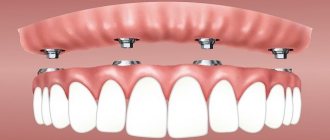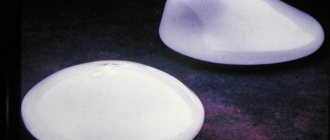Consultation with plastic surgeons with over 20 years of experience – free! Sign up by phone. Waiting for you! Large breasts can cause a woman a lot of inconvenience: pain in the neck, back, shoulders, constant diaper rash under the breasts, which is why many women undergo breast reduction surgery. Large breasts can also cause more serious changes in a woman’s body: provoke the development of stoop, headaches, breathing problems and even neck deformation. Plastic surgery for breast reduction is performed not only for aesthetic reasons and the wishes of the woman, but also for medical reasons.
Photos "Before" and "After"
REDUCTION AND LIFTING OF THE BUST FOR A YOUNG MOTHER
See more “Before” and “After” photos
Very large mammary glands are a “dubious” joy. Owners of such busts face a number of problems:
- neck and back pain
- difficulty playing sports
- problems with choosing underwear
- chafing bra straps
- irritation and diaper rash under the breasts
- risk of tumors
- rapid loss of attractiveness of forms
Large bust and health risks
Perhaps a large bust visually seems sexy and beautiful, but its owners are unlikely to agree with this. Breast hypertrophy leads to the development of many health problems.
The most obvious consequences:
- pain in the spine;
- osteochondrosis and poor posture;
- stoop and curvature of the cervical vertebrae;
- headache due to cerebrovascular accident;
- cardiovascular problems;
- skin inflammation and ulcers;
- risk of breast cancer.
In addition, the inability to choose beautiful underwear brings special discomfort to a woman with large breasts. Even the very fact of wearing it can cause serious pain due to hypertrophy of the mammary glands.
Why is the operation of increased complexity
- Removal of large amounts of tissue
Reduction mammoplasty involves excision of a significant amount of breast tissue. That is, the wound surface is quite extensive. The larger the incisions, the higher the risk of various types of complications.
- Features of blood circulation of the mammary gland
The second important point is the comparison of fabrics to create the desired shapes and transfer of the areola to a new place. To carry out these manipulations without complications, the surgeon must thoroughly know the blood supply system of the mammary gland and its anatomy. The larger the breast, the worse the blood circulation in the area of the areola and nipple. By moving the areola higher, the doctor must preserve the blood supply to the areola and nipple. This is not an easy task when dealing with excess tissue volumes.
- Breast remodeling
In addition to removing an impressive amount of tissue, which also needs to be done delicately, the surgeon is faced with the task of creating a new model of a reduced mammary gland. It is much easier to do this with an implant.
⇒ WE ALSO ADVISE YOU TO READ: Breast surgery after pregnancy and breastfeeding
See more “Before” and “After” photos
Operation methods
The simplest method is lipoaspiration. But it is used only in rare cases, since the main indication for its implementation is breast hypertrophy. Lipoaspiration is performed if the skin has good elasticity and there is no sagging breasts. This method is often used in combination with traditional breast reduction. It is based on the correction of fat folds, which are located in the area of the axillary line, as well as along the lateral surface of the chest.
The most commonly used is a vertical scar. Initially, the surgeon makes an incision around the areola, thereby reducing it. Then he continues it to the inframammary fold, moving vertically downwards. This method is quite effective and allows you to reduce medium-sized breasts and make them more toned.
If the breasts are large, the surgeon will initially make an incision around the areola and towards the breast crease. The vertical dimension is complemented by the horizontal, forming an anchor shape.
Where will the scars be located?
Unfortunately, it is not possible to perform breast reduction surgery with minimal incisions. Be prepared for the seams to be a concern for some time and require some care.
The inverted T suture (T-shaped, anchor suture) has become a classic in reduction plastic surgery. This is the optimal technique that allows the surgeon to preserve all the vital anatomical structures of the mammary gland, not to disrupt blood circulation, and at the same time achieve a stable aesthetic effect.
The healing and appearance of the scar depends on the skill of the surgeon, the characteristics of patient skin regeneration and postoperative care. As a rule, a year after breast reduction, the scars turn into barely noticeable thin stripes.
⇒ WE ALSO ADVISE YOU TO READ: Breast Augmentation: Debunking Popular Myths
The photo shows resection of glandular tissue, transfer of the nipple-areolar complex, excision of excess skin
Recovery
Most patients will be able to go home within a few hours after surgery if they do not experience any complications.
Before they leave the hospital or clinic, they receive specific postoperative instructions that cover what types of oral and topical medications can help reduce pain and scarring and prevent infections.
Patients will need to get plenty of rest while their body heals. They should avoid any movements that could strain the pectoral muscles or tear the stitches.
Patients may have difficulty lifting their arms during the first few weeks, so it is best to ask a close family member or friend to help them during this time.
They should also avoid heavy lifting for several weeks or until the doctor removes the stitches.
How to prepare the body
It all starts with moral preparedness and consultation with a specialist. If you have weighed the pros and cons and decided that you really need it, schedule an appointment with a plastic surgeon.
Choosing a surgeon is a responsible undertaking. Focus on three factors: experience, number of breast reduction surgeries, and honesty in conversation. A specialist who has performed many plastic surgeries will definitely tell you about the technique, possible risks, and answer your questions in detail.
The next stage is taking tests in accordance with the list.
WE ALSO ADVISE YOU TO READ: Breast lift with and without implants
Possible risks
This operation is not simple and requires a lot of experience and concentration from the surgeon. But the number of risks is quite small. As after any surgical intervention, swelling and hematomas may appear. But in most cases they go away on their own without any treatment. Risks also include:
- infection of the wound edges;
- disruption of its healing process;
- temporary numbness of the nipples and skin;
- loss of sensitivity, which can be either temporary or permanent;
- breast asymmetry.
The risks described above occur quite rarely, and often the reason for their development is the lack of qualifications of the doctor or the patient’s failure to comply with these recommendations. Professionals work abroad and use modern equipment, which allows us to minimize the likelihood of their occurrence.
List of tests
- ECG (electrocardiogram) with interpretation
- Clinical blood test
- Biochemical blood test (total protein, urea, creatinine, bilirubin (total), ALT, AST, glucose, potassium, sodium)
- Coagulogram (INR, prothrombin, bleeding time, clotting time)
- Blood test for RW (syphilis), HIV
- General urine analysis
- Hbc
- antigen + anti HCV (hepatitis B, C)
- Blood group, Rh factor
I recommend saying goodbye to bad habits (smoking, alcohol) 2-3 weeks before plastic surgery for breast reduction. Nicotine lovers are at high risk of complications in the form of slow and painful healing.
Rehabilitation
If the early recovery process is successful, the patient goes home one day after breast reduction.
- During rehabilitation, you must wear thick compression garments for a month.
- To reduce swelling, bruises, and hematomas, the doctor may prescribe physiotherapy.
- For a speedy recovery, physical activity, sports, visiting the bathhouse, and solarium are prohibited for some time.
WE ALSO ADVISE YOU TO READ: Skin problems after losing excess weight
What results can you expect?
At first, the mammary glands will have a slightly unnatural shape: a very full top and a flattened bottom. After 4-6 months, the breasts will take on a natural teardrop shape. The final result of breast reduction will appear after a year.
What not to do?
In the first 1-1.5 months, physical activity and sports are prohibited. Avoid activities that involve bending your body down. Visits to baths and saunas, hot baths and other thermal procedures are also not allowed. Exposure to heat promotes blood flow to injured tissues and delays their healing time.
Visiting solariums or beaches is also not allowed. The operated area must be protected from ultraviolet rays, since ultraviolet radiation has an adverse effect on scar tissue. The effect of ultraviolet radiation can subsequently lead to the appearance of noticeable scars.
It is undesirable to expose the breasts to any impact - pressure, kneading, pressing, and so on. It is strictly forbidden to remove compression garments for a long period of time. It is highly recommended to give up alcohol and cigarettes at least for the period of rehabilitation.
At what age can you have a breast reduction?
There is a certain stereotype regarding large bust size: large, sagging breasts are typical of older ladies. Yes, with age, tissues stretch, and the once lush, luxurious bust drops significantly. In my practice, there are quite a few young girls who needed plastic surgery to reduce their mammary glands.
Breast reduction is best done at a young or relatively young age (under 50 years of age). This is due to the body’s resources, which are responsible for post-operative recovery. At a young age, there are fewer concomitant diseases, stronger immunity, and higher regenerative abilities. A younger and stronger body will undergo a rather complex breast reduction operation more easily. You can evaluate before and after photos of breast reduction on the website.
Breast reduction before or after childbirth
You should know that breast reduction is a serious breast surgery that is best performed after pregnancy. During work with tissues, the innervation of the areola and nipple may be disrupted, glandular tissue and milk ducts may be affected. Breastfeeding can be restored after plastic surgery with a 50/50 chance. Therefore, I recommend plastic surgery after the birth of a child.
Pregnancy is a factor that negatively affects the stability of the result. The mammary glands may stretch and lose their shape.
WE ALSO ADVISE YOU TO READ: Possible complications after breast augmentation
Medicines
As mentioned earlier, if severe pain occurs, the surgeon may prescribe painkillers. In some cases, a course of antibiotics may also be indicated if there is a risk of developing an infectious inflammation in the operated area. Vascular and complex medications are required to improve microcirculation and tissue trophism.
Sutures are removed 8-10 days after surgery. Before removal, the incision sites must be treated with antiseptic agents. The surgeon may also prescribe certain medications that will help speed up tissue regeneration and scar healing.
It is strictly forbidden to prescribe various medications yourself, much less take them! Any medicines, including traditional medicine, must first be agreed with a surgeon.
How much does breast reduction surgery cost?
The price will be known after consultation with a specialist at the clinic. Not only residents of the capital can undergo breast reduction surgery. Patients from Volgograd, Voronezh, Yekaterinburg, Kazan, Krasnoyarsk, Nizhny Novgorod, Novosibirsk, Omsk, Perm, Rostov-on-Don, Samara, Ufa, Chelyabinsk and other cities of Russia come to the clinic of Vladimir Kosinets.
| Breast plastic surgery (mammoplasty) | Prices |
| Breast reduction with lift | 200 000 |
| Augmentation with round implants | 200 000 |
| Repeated mammoplasty | 260 000 |
| Periareolar mastopexy with breast augmentation | 250 000 |
| Vertical mastopexy with breast augmentation | 280 000 |
| T-shaped mastopexy with breast augmentation | 300 000 |
| Vertical reduction mammoplasty | 200 000 |
| T-shaped reduction mammoplasty | 250 000 |






